Whether you call it “The Great Stay,” “The Great Hesitation,” or some other cheeky name, the U.S. labor market has undergone a change over the past year—one in which workers’ keisters are increasingly staying parked in their Herman Miller knockoffs.
But why, after a couple years in which workers bolted from one job to the next, have employees become less mobile? Well, sit back, grab your “Monday is the problem. Coffee is the cure” mug, and we’ll discuss this shift in the workplace environment, what’s causing employees to be more stationary, and—for those who still want to escape—a few things you can do to improve your odds in the job market.
The Tea
The COVID pandemic triggered or contributed to a vast and varied number of economic events, and among the more noteworthy was the Great Resignation.
A few months into 2020, COVID effectively slammed the brakes on economic activity as the world’s governments fought to combat the quickly spreading disease. But by 2021, the end of lockdowns and the resumption of most business activity opened up a floodgate of pent-up demand. This sent the economy into overdrive and compelled employers to ramp up hiring.
At the same time, employees were more mobile than ever thanks to a rapid corporate adoption of work-from-home (WFH) policies. So, Americans often weren’t limited to jobs within close proximity—as long as they had an internet connection, they could fill roles across the country.
WealthUp Tip: Working from home doesn’t just offer lifestyle flexibility. These remote careers also offer extremely attractive pay.
This led to a dizzying amount of workplace upheaval. In 2021, a record-high 47.8 million Americans quit their jobs, only to be outdone in 2022, as 50.5 million Americans bid their bosses adieu.
The trend was so remarkable that it infiltrated popular culture. CNBC offers up some varied examples: “Beyonce song lyrics riffed on quitting and the stress of a 9-to-5 workday. Americans turned to the social media site TikTok to post “Quit-Toks,” and to Reddit forums to share stories about quitting and resignation text messages to bosses.”
But since the back half of 2022, the Great Resignation has morphed into the Great Stay.
Two pieces of data tell the tale:
1.) The quit rate. The quit rate, which is the percentage of total employment that voluntarily leaves their jobs in a month, is gathered by the Bureau of Labor Statistics (BLS) via its monthly Job Openings and Labor Turnover Survey (JOLTS). As you can see here, the quit rate began surpassing pre-COVID levels in 2021, peaked and plateaued through mid-2022, and has mostly tapered off since.
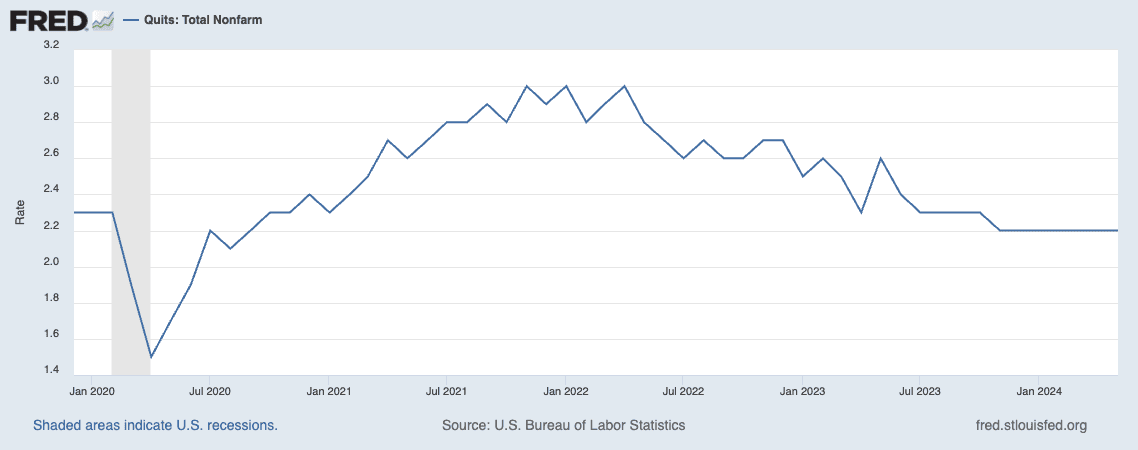
2.) The job-to-job (J2J) change rate. Job-to-job moves are, as the name would imply, instances of an employee exiting one job to take another (as opposed to quitting but not finding new employment). The data used in the chart below is gathered by Bank of America, and shows a sharp decline starting near the start of 2023.
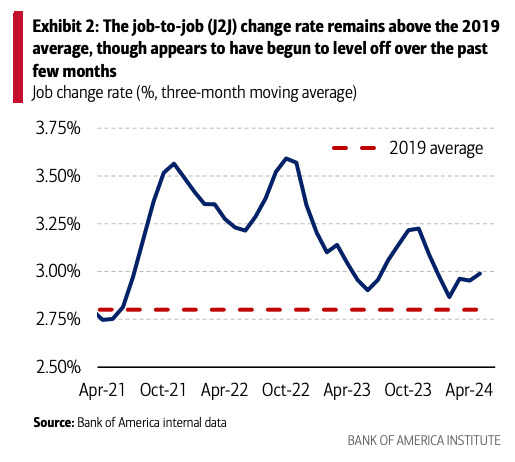
So, what exactly has calmed America’s employment wanderlust?
The Take
Context is important here. If you look at longer-dated data, you’ll find that while job hopping is indeed in decline, it’s also normalizing. If we take a look at quit data going back 24 years instead of just four …
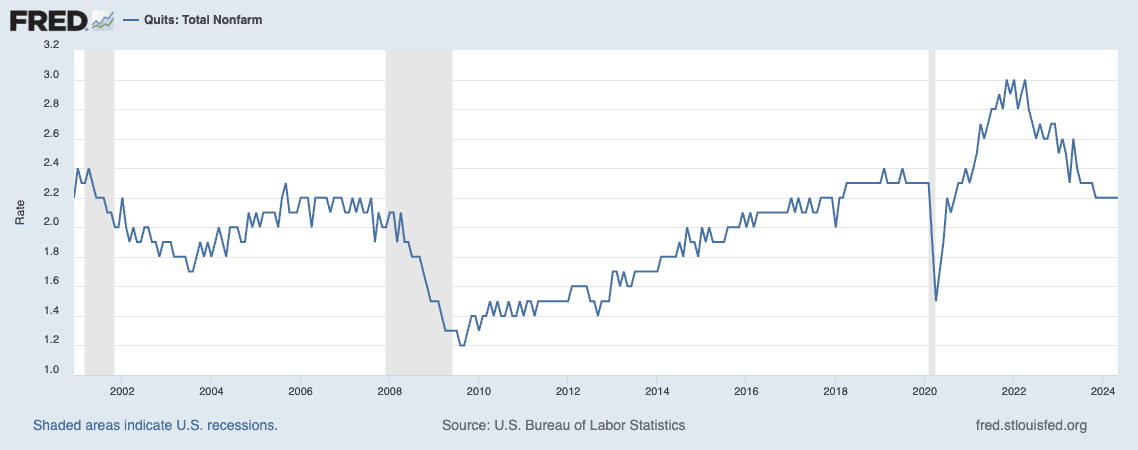
In fact, the quit rate has merely returned to its pre-COVID level … which itself represented a recovery to pre-Great Recession levels.
Still, the “why” is worth pursuing.
The simple answer is “the economy, stupid.” The Federal Reserve began a series of interest-rate hikes in March 2022 to combat skyrocketing inflation—a byproduct of the aforementioned red-hot economy. As borrowing costs started to climb, and the economy began to cool, order started to return to The Force … well, in Order 66 fashion, anyways. Many companies, especially in technology-related industries, began to throttle back their aggressive hiring practices. In some cases, posted jobs were left out in the ether.
And fewer job openings obviously meant fewer opportunities for people to hop along.
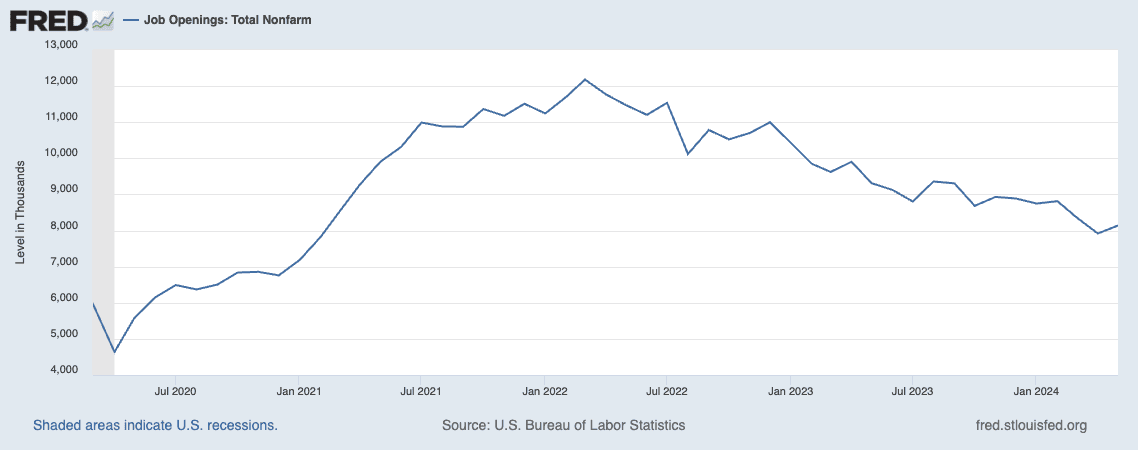
Some employers further tightened their grip on existing employees by shifting away from WFH and instead adopting RTO (return to office). To be clear: Virtually all gauges of employee office presence—such as badge swipes, office real estate rental rates, office real estate vacancies, etc.—show that we’re nowhere near pre-COVID levels of office employee presence. But the WFH trend has decidedly reversed.
WealthUp Tip: You don’t want to be trapped in a dead-end career. So be wary of these dying (or evolving) professions.
And the once eye-popping raises one could expect from switching employers have seemingly come back to earth.
“With signs that J2J moves are gradually moderating, we also find that job hoppers are getting a smaller bump in pay at their new employers,” says the Bank of America Institute. “Exhibit 4 shows an estimate using Bank of America data of the median pay raises people receive when they make a J2J move. When the Great Resignation was in full swing, this appears to have risen to above 20%, but as of May 2024, median pay raises appear to have moderated to around 10% for J2J moves.”
That’s even lower than 2019 levels, BofA adds.
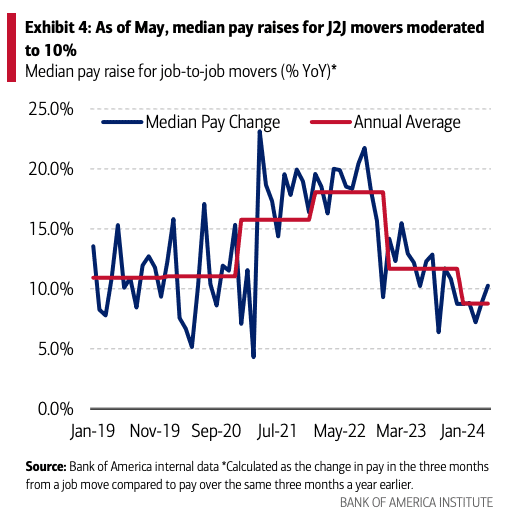
The decline in pay bumps isn’t evenly distributed, though. BofA notes that lower-income employees have maintained the strongest median pay raise from a job change—it’s the middle- and higher-income employees that have suffered larger slowdowns compared to 2022 Great Resignation highs. Or, in other words, it’s medium- and high-paid earners who are losing the most leverage.
And, of course, as workers become aware of their relative lack of leverage and softening job market, many are choosing to “play it safe” and instead focus on securing the job they have.
How Can You Help Your Chances If You Still Want to Leave?
Naturally, some people want to leave their current employers regardless of how tight the job market is. This is hardly a comprehensive list, but here are a few quick tips to improve your chances of getting noticed by a prospective new employer and get hired.
Triumphs, Not Tasks
In most of the resumes we’ve reviewed (both here and in previous roles), applicants have put the strongest emphasis on their responsibilities. That information is helpful, but it only says so much.
What makes a resume shine is communicating how you’ve contributed to the company—did you drive growth in traffic, can you point to a tangible return on investment (ROI), did you win awards? Employers want to know what you do, sure, but they also want to know how well you do those things.
Network (Before It’s Too Late)
We’d bet the farm you’ve been told numerous times to network—reach out and build relationships with people in your industry and beyond. But it’s advice that many people only take seriously once they’ve been laid off and suddenly need a new job. And at that point, it becomes much more difficult to make those connections.
In some industries, especially at larger employers, networking won’t take you very far—potential hires are only found through stringent system-based applications, and there’s nowhere in the process for someone to put in a good word. But in many spots throughout corporate America, who you know can quite literally give you an edge. We don’t mean nepotism, either. In many cases, making the right connections can help you get introduced to hiring managers and other key personnel before they have a need, allowing you to make an impression that might stick with them when it’s time to bring in new personnel.
Ask the Right Questions
Throughout the interview process, you’ll be given numerous opportunities to ask questions. You should! An interview is a two-way street: An employer is interviewing you, but you’re also interviewing the employer. But be strategic about what questions you ask and how you ask them.
For instance, don’t just ask about the position’s responsibilities—also ask about what role the position takes in helping the company grow. Don’t just ask about who you’d be working with—also ask about the company’s culture and how different departments work with one another. Don’t just ask about compensation—ask about opportunities to grow within the company, and whether the company provides resources to improve your skills, gain certifications, and even earn a degree.
WealthUp Tip: No college degree? No problem. These high-paying jobs require little more than a high school diploma.
Improve Yourself
Speaking of skills: Get some more! With the exception of Curt Hennig, nobody is perfect. Whether it’s mastering new software, studying industry trends, or even taking leadership courses, leveling up will make you more valuable at your current job. Of course, if you’re certain you want to leave your current job, don’t consider “upskilling” as additional time dedicated to your current job—think of it as spending time to secure your eventual exit.
Be a Decent Person
You’ve heard it all before. Nice guys finish last. It’s a dog-eat-dog world. But you’d be surprised at how many seemingly “lucky” moments you’ll have throughout your career if you treat everyone—co-workers, bosses, subordinates, partners, customers … everyone—with decency and respect. This isn’t a call to always be cheery or even nice, and it’s certainly not a suggestion that you turn yourself into a doormat. But you’d be surprised how often terms like “integrity,” “team chemistry” and “honesty” come up during reference calls while checking out the truly best candidates. This characteristic will make people not just want to work with you—but also vouch for you when you want to make the next move in your career.
Have yourselves a great rest of the weekend, and—if you’re looking—a successful job hunt!
Riley & Kyle
WealthUp + Young and the Invested
Like what you’re reading but not yet a subscriber? Get our weekly financial insights and updates delivered to your inbox every Saturday morning by signing up for The Weekend Tea today! You can also follow WealthUp on Flipboard for more great advice and insights.







